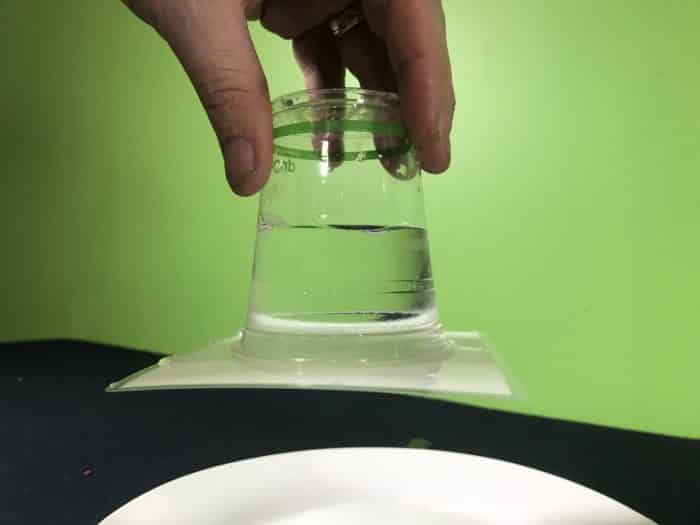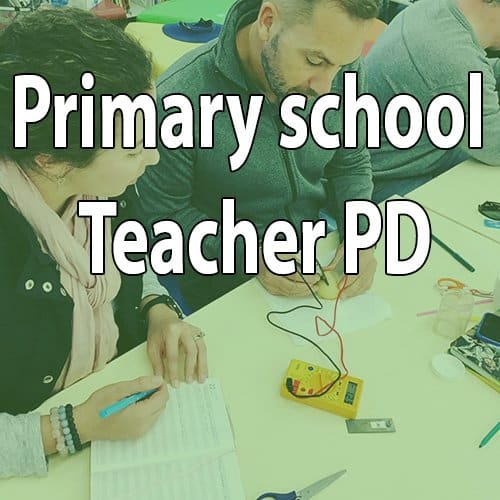Air pressure can be a difficult concept for learners to grasp. As air is invisible and is three-dimensional, it can be a challenge to understand what is going on without some concrete examples. To help with this, the following is a list of a bunch of experiments that you can do to help students understand more about air pressure!
Air pressure experiments that use simple materials
Air takes up space
The pressure exerted by the air inside the glass allows the air to exclude the water and the ping pong ball. Push down all the way to bottom of the container. Using the tissue helps to show that air, not water, is trapped inside the glass. Great guessing game if you ask the class where they think the ball will go!
Upside-down water cup
Make sure your cup is completely full, i.e. about to spill over the side. Gently place a dry card or paper on top of the cup… making sure there is good contact over the cup rim. Carefully turn the cup upside down! The air pressure underneath the cup pushes that paper upwards into the cup, keeping the water from falling.
Balloon push-in
- Put a funnel into a glass bottle and put hot water into the bottle.
- Wait 10 seconds and then pour the water back into the kettle
- Place a balloon over the neck of the glass bottle.
- Place the bottle in the clear plastic container with cold water in it.
- Stretch the balloon slightly and wait for the balloon to be squeezed together by the air pressure.
- Let go of the balloon and it will be pushed into the bottle
Misconception: people often think the balloon is ‘sucked’ into the bottle… its the opposite effect actually as it is pushed from high to low pressure. SAFETY: Make sure that students are not near the demonstration to avoid accidental scalding. Similar to the egg into the bottle experiment!
Impossible puff
Place a ping pong ball in the funnel. Have a volunteer try to blow the ball out of the funnel (it’s impossible). Now blow across the top of the funnel and it will come straight out. This shows the Bernoulli theorem in action whereby the ball is pushed from slow air (high pressure) toward where the air moving fastest (low pressure).
Ping pong on a string
Tape a string onto a ping pong ball and hold near a stream of running water. The ping pong ball will move towards the fast running water. This again shows the Bernoulli theorem in action whereby the ball is pushed from slow air (high pressure) toward where the air moving fastest (low pressure).
Blow them apart
Tie string around the end of balloons and suspend them near each other. Have a student try to blow the balloons apart… it’s impossible! In your experiment, a low-pressure area was created between the balloons when you tried to blow them apart. The faster air moved between the balloons, creating a low-pressure zone between the balloons. The high pressure surrounding the balloons pushed the balloons together.
Bernoulli bag blow up
Fast air from your breath into the bag will draw slow air from around the room into the bag as per Bernoulli’s theorem (fast air is low pressure, slow air is high pressure). Keep your face 30cm away from bag opening. Be careful not to pop bag when you close the bag and squeeze the opening to tighten the bag.
Rising water
Cover a lit candle sitting in a bowl of water with a glass cup. Watch the water rise into the cup. If you want, you can add food colouring into the water to make the experiment more visible. During the experiment, you can see tiny bubbles escaping under the glass which shows that the air pressure is increased from the heated air as the candle burns. Once the candle runs out of oxygen, the candle burns out and the remaining air inside cools down. Cooling air contracts which lowers the air pressure inside the cup. This created a pressure difference between the air inside the cup and air outside the cup. This pressure difference caused the high-pressure air outside the cup to push the water down into the plate… allowing the water to be pushed upwards into the inside of the cup towards the lower pressure air inside.
Cartesian diver
Cut the end off of a plastic pipette and add two 5mm metal nuts onto the end of the bulb. Add this to a plastic bottle filled water and squeeze on the bottle… the pipette diver sinks! Squeezing the bottle exerts a pressure throughout the contained fluid. This pressurised fluid rises into the opening at the bottom, making the pipette heavy and therefore it sinks. Releasing the bottle reduces the pressure around the pipette, allowing the trapped air inside the pipette to expand, increasing its buoyancy and allowing it to float.
Ball levitator
Have a volunteer choose to hold either the leaf blower or the ball. Turn on the leaf blower and place the ball into the fast air. The ball will initially be pushed by the force of the air but not so far as to be completely pushed away. This is due to the air furthest from the leaf blower being slow air (high pressure), which pushes the ball back toward the blower. You can angle it at 45 degrees before gravity pulls it to the ground. A hairdryer and a ping pong ball also works!
Flying toilet paper
Place a toilet paper roll on a paint roller. Aim the paint roller with toilet paper at a target and position leaf blower over toilet paper surface. Air travels faster over the top of a wing than the bottom. Why? The upper surface of a wing is longer than the bottom of the wing. According to Bernoulli, fast travelling fluids and gasses have a lower pressure than slow-moving fluid and gases.
Teaching air pressure with a bell jar
Balloon in a bell jar
Explain parts of the mechanism (vacuum pump, bell jar, rubber diaphragm, tubing etc).
- Blow up a balloon and place in the bell jar.
- Turn on the vacuum pump and watch the balloon expand.
- Turn the valve flowing to the vacuum pump and then turn off the vacuum pump (CRITICAL, otherwise you will pull hydraulic fluid into the hose due to low pressure in the bell jar).
- Disconnect the hose from the vacuum pump
- Open the valve to bell jar and watch the balloon deflate.
Air moves from high to low pressure. The balloon has higher air pressure inside it as the air is pulled from the jar therefore it expands and pushes the balloon outward. Try making a balloon dog and placing it in the bell jar!
Expand shaving cream in a bell jar
Put a small amount of shaving cream in a plastic shot glass and then place into bell jar. Turn on the vacuum pump and watch it expand! Shaving cream has a lot of tiny bubbles in it. Decreasing the pressure around the cream causes the bubbles to expand from high to low pressure.
Marshmallows in a bell jar
Try putting some marshmallows and toothpicks together to make a growing marshmallow man in a bell jar!
Boil water in a bell jar
Explain parts of the mechanism (vacuum pump, bell jar, rubber diaphragm, tubing etc).
- Place ½ cup of warm water in clear plastic cup
- Put a cup into the bell jar
- Turn on the vacuum pump
- Water will boil after 1 minute or so
Boiling is not just about temperature. As you remove pressure some of the water molecules are able to change to gas as there is less pressure holding them in a liquid state. If you run this for several hours you can turn the water to ice!
Happy teaching,








































Comments